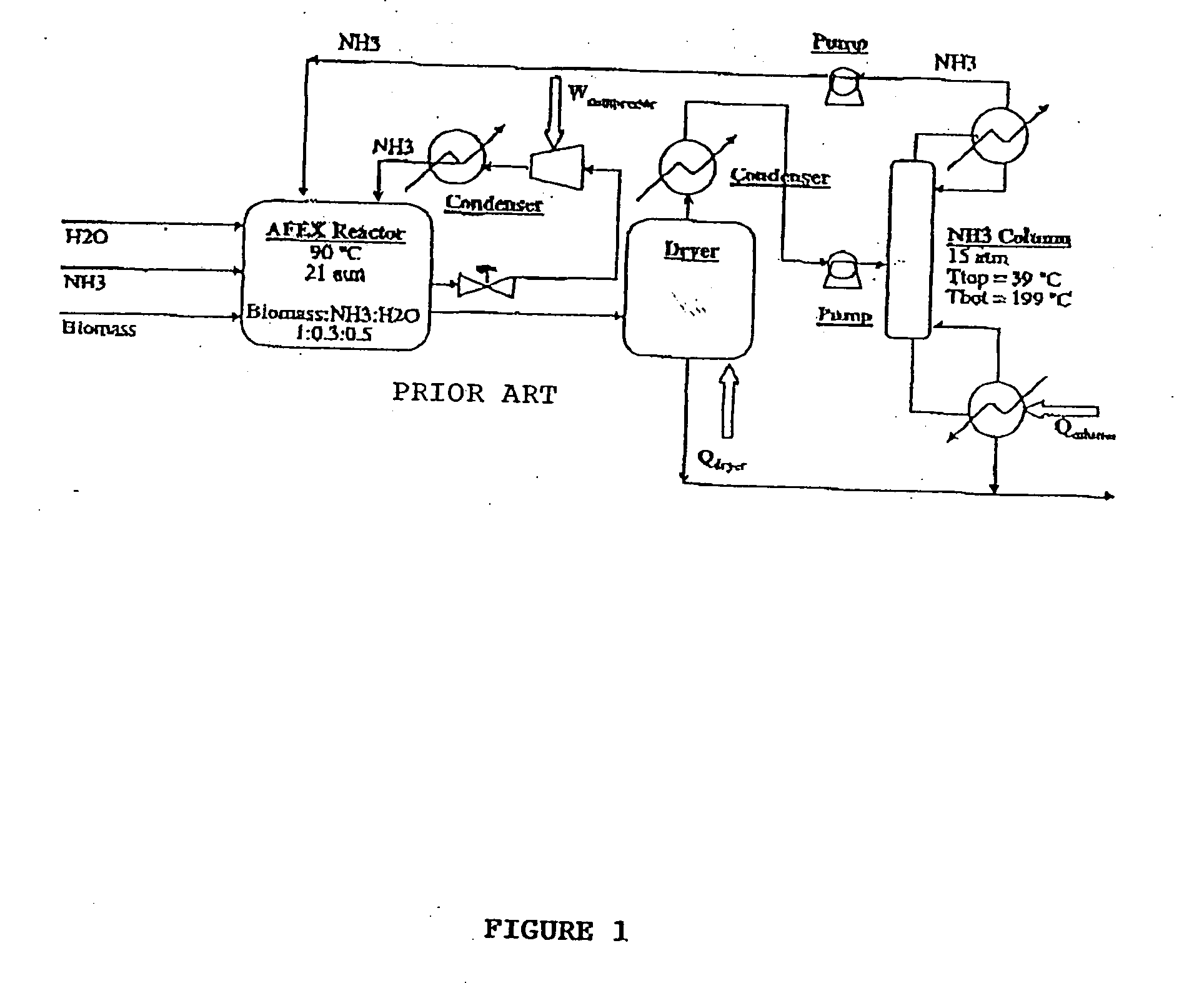Process for the treatment of lignocellulosic biomass
a technology of lignocellulosic biomass and processing method, which is applied in the field of processing process for lignocellulosic biomass, can solve the problems of less effective production of highly reactive biomass by combing the same final conditions, and achieve the reduction of the amount of ammonia required to obtain the desired glucose yield, the effect of increasing the fraction of total ammonia and reducing the volume of the headspa
- Summary
- Abstract
- Description
- Claims
- Application Information
AI Technical Summary
Benefits of technology
Problems solved by technology
Method used
Image
Examples
examples 1 to 20
[0052] A 300 ml pressure vessel 102 was first filled with a given mass of corn stover wetted to the desired moisture level as indicated in Table 1 and the vessel 102 was sealed. Then a concentrated ammonium hydroxide mixture was prepared by mixing the right proportions of anhydrous ammonia and water in another pressure vessel and this mixture was added to the corn stover in the 300 ml reactor vessel 102 to achieve the desired final level of ammonia and water. In this case, the target was 1 kg of ammonia per kg and dry biomass and 0.6 kg of water per kg of dry biomass. The mixture of ammonia, water and biomass was then heated to 90° C., held at that temperature for 5 minutes and the pressure rapidly released.
[0053] The resulting solid was hydrolyzed to mixtures of monosaccharides containing, for example, glucose, xylose and arabinose.
[0054] The results of the present invention are shown in Table 1 and Examples 2 to 15.
TABLE 1Glucose and Xylose yields of ammonia treated corn stove...
example 20 (
c) shows the process without ammonia.
[0055] Table 1 shows the results for the conversion of corn stover to glucose and xylose following treatment with ammonia and water. The total amount of water, ammonia and biomass and the system temperature is the same in all cases. The biomass was treated with 1 kg of ammonia per 1 kg dry corn stover biomass (the untreated stover has a moisture content of about 15% dry basis). The experiments were run at 90° C. with a five minute holding time at that temperature and the treated material of Example 1 was hydrolyzed with 15 filter paper units of cellulose per gram of cellulose in the stover. From the point of view of the final conditions to which the stover was subjected, these conditions are identical. However, the way in which these final conditions were reached was varied significantly and novel, surprising results were obtained.
[0056] Columns 3 and 4 of the Table show how this was done. For example, the column titled “Ammonia Distribution” sh...
examples 21 to 36
AFEX Treatment of Corn Stover Under Nitrogen Pressure
Objective:
[0075] The main objective of these series of experiments was twofold: [0076] 1. To establish the fact that the ammonia in the liquid phase where it is in direct contact with the biomass is preferred phase that makes the AFEX an effective pretreatment process. Therefore, to minimize ammonia evaporation, applying nitrogen pressure during pretreatment of biomass is warranted. [0077] 2. To optimize the ammonia loading under nitrogen.
Experimental Procedure:
[0078] Old corn stover with 36.1% Glucan content was received from NREL (Golden, Colo.). The moisture content of the biomass was adjusted from 10% to the desired level before placing in the reactor. The reactor was a 300 ml PARR unit with pressure and temperature monitoring attachments. The sample in the reactor topped up with some spherical steel balls to reduce the void in the reactor and to have similar conditions with experiments without use of nitrogen.
[0079] A...
PUM
| Property | Measurement | Unit |
|---|---|---|
| Temperature | aaaaa | aaaaa |
| Temperature | aaaaa | aaaaa |
| Fraction | aaaaa | aaaaa |
Abstract
Description
Claims
Application Information
 Login to View More
Login to View More - R&D
- Intellectual Property
- Life Sciences
- Materials
- Tech Scout
- Unparalleled Data Quality
- Higher Quality Content
- 60% Fewer Hallucinations
Browse by: Latest US Patents, China's latest patents, Technical Efficacy Thesaurus, Application Domain, Technology Topic, Popular Technical Reports.
© 2025 PatSnap. All rights reserved.Legal|Privacy policy|Modern Slavery Act Transparency Statement|Sitemap|About US| Contact US: help@patsnap.com



